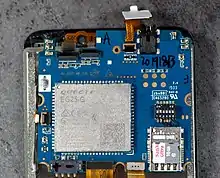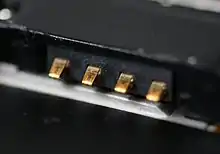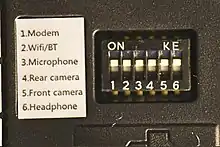PinePhone
The PinePhone is a smartphone, developed by computer manufacturer Pine64, intended for allowing the user to have full control over the device. Measures to ensure this are running mainline Linux based mobile operating systems, assembling the phone with screws, simplifying the disassembly for repairs and upgrades,[5] and including six kill switches / security switches for its hardware, which are accessible by removing the back cover of the phone.[6]
 A Pinephone running Ubuntu Touch | |
| Brand | Pine64 |
|---|---|
| Dimensions | 160.5mm x 76.6mm x 9.2mm[1] |
| Mass | 185 grams[2] |
| Operating system | Plasma Mobile, Ubuntu Touch, PostmarketOS, Sailfish OS, Android, any Linux-on-a-phone system, any ARM-compatible Linux system |
| CPU | Allwinner A64 ARM Quad core Cortex-A53, 64bit @ max1.2GHz |
| GPU | Mali-400 MP2[3] |
| Modem | Quectel, integrated |
| Memory | 2 or 3 GB LPDDR3[3] |
| Storage | 16 or 32GB eMMC flash memory [3] |
| Removable storage | bootable microSD[3] |
| Battery | 3000mAh, Samsung J7 form-factor, user-replaceable (est. cost $10 US)[4] |
| Data inputs | sensors: Other
|
| Display | 720×1440 5.95″ IPS LCD[3] |
| Rear camera | Single OV5640, 5MP, 1/4″, LED Flash |
| Front camera | Single GC2145, 2MP, f/2.8, 1/5″ |
| Connectivity | Wi-Fi 802.11 b/g/n, single-band, hotspot capable, Bluetooth 4, A2DP, 3.5mm headphone jack, USB-C USB 2.0 PD/DisplayPort |
Distribution History
Pine64 sold limited editions of the PinePhone marketed towards developers and early adopters. The phone did ship worldwide with few geographical restrictions, and some regions may have been subject to additional Customs fees and VAT costs. The "BraveHeart" Edition was the first publicly available version of the phone, providing only a test firmware so the end user could test their phone before installing their own operating system of choice.[7]
Pine64 partnered with existing and well established Linux-on-phone projects to launch a "Community Edition" campaign to incentivize software development for the device.[8] Through this partnership, Pine64 donated $10 for each unit sold to the project maintainers. Each Community Edition features a branding on the back cover of the PinePhone itself and ships with a custom box designed by the partnered artists. The "Mobian" Community Edition is the last Community Edition to be offered.[9]
Initially the PinePhone was only available in one hardware configuration. The enhanced "Convergence Package" was introduced with the postmarketOS Community Edition announcement, featuring increased RAM, additional eMMC storage, and a USB-C dock. The bundled docking bar is capable of delivering power to the phone via USB-C power-in (3A 5V), outputting digital video via HDMI, 10/100Mbps Ethernet connectivity, and two USB 2.0 ports (for e.g. external storage / mouse and keyboard).[10]
| Model | Pre-installed OS | Pre-order Date | Shipping Date | Hardware Revision | Price |
|---|---|---|---|---|---|
| BraveHeart Edition[7] | Factory Test Image | November 15, 2019[11] | January 17, 2020[3] | v1.1 | $149 - 2GB RAM; 16GB eMMC |
| UBports Community Edition[12] | Ubuntu Touch | April 2, 2020[13] | May 2020 | v1.2 | |
| postmarketOS Community Edition[14] | postmarketOS | July 15, 2020[15] | August 25, 2020 | v1.2a | $149 - 2GB RAM; 16GB eMMC
$199 - 3GB RAM; 32GB eMMC (includes a USB-C dock) |
| Manjaro Community Edition[16] | Manjaro ARM | September 17, 2020[16] | October 30, 2020 | v1.2b | |
| KDE Community Edition[17] | Plasma Mobile on a customized installation of Manjaro ARM[18] | December 1, 2020[17] | January 2021 | v1.2b | |
| Mobian Community Edition[19] | Mobian | January 17, 2021[19] | February 2021 | v1.2b |
Features and comparison to other Linux-based phones

The PinePhone is often compared to other phones shipping with non-Android Linux distributions, especially the Librem 5, which released around the same time, and the WiFi-VoIP phone Necuno, which does not employ a cellular modem.
Pine64 promises 5 years of production. The long production life and sharing a common A64 platform with the PineTab tablet and Pine A64 boards is meant to encourage tinkerers to create mods and DIY projects based on the PinePhone.
Hardware
The PinePhone uses an Allwinner A64 processor, which has four Cortex-A53 cores clocked at 1.152GHz and a Mali-400 MP2 GPU. Its frame and case cover is made of plastic. It contains a 5 megapixel back camera and a 2 megapixel front camera and a USB-C port with USB 2.0 that supports DisplayPort alt-mode. Its 3000 mAh battery supports 15W fast charging and is easily replaced without tools. It uses the same form factor as a Galaxy J7 battery to make it easier to find replacement batteries.[20] Different distros are setting its LPDDR3 DRAM at clock rates that vary between 552 and 624 MHz.[21]
Like the Librem 5, the PinePhone uses separate cellular baseband and WiFi/Bluetooth chips and hardware kill switches which results in larger printed circuit boards (PCBs) and less energy efficiency compared to the standard Android phone that uses an integrated System on a Chip, such as the Snapdragon, Helio or Exynos. The PinePhone is thinner at 9.2 mm than the Librem 5 which is 15.5 mm thick, because the PinePhone solders its wireless communication chips to the PCB whereas the Librem 5 places the cellular baseband and WiFi/Bluetooth on two removable M.2 cards.[1][22][23]
Pine64 is the second phone maker (after OpenMoko) to offer booting from a microSD card, which allows users to try out multiple operating systems, before installing in the internal Flash memory.
Another distinctive feature of the PinePhone is the 6 pogo pin I2C connector under the back cover, which can be used for adding mods to the phone.[24] Pine64 has reported that it is developing 4 mods, which include a physical keyboard,[25] a 5000 mAh battery, wireless charging[26] and a fingerprint sensor.[27]
 Battery front view |
 rear view |
 Terminals on battery  Battery terminals on PinePhone |
PinePhone battery has four terminals:
|
|---|
The PinePhone has 6 DIP switches under the back cover, the first five of which switch off the following components:
- Cellular modem/GNSS
- WiFi/Bluetooth
- Microphone
- Rear camera
- Front camera

The sixth DIP switch will convert the 3.5 mm headphone jack into a UART serial port,[28] which is the first time this kind of switch has been included in a mobile phone.
Software
The PinePhone aims to be fully open source in its drivers and bootloader. Despite this, due to the scarcity of open source components for cellular and wireless connectivity, the firmware for the Realtek RTL8723CS WiFi/Bluetooth, as well as the optional auto-focus firmware for the OmniVision OV6540 back camera, remain proprietary software. In order to mitigate potential threats to privacy, these components are communicating with the rest of the system only over serial protocols, such as USB 2.0, I2S and SDIO, which do not allow direct memory access (DMA). Integration via these protocols is also what allows them to be physically disconnected via kill switches. [29]
In late 2020 Pine64 started an incentive called Nutcracker Challenge in order to encourage the development of open source wireless networking on the BL602 wifi and bluetooth board.[30]
Operating systems
The PinePhone relies completely on open-source operating systems developed by external communities, with only the flashing onto the phone done by Pine64 directly.[31] Because these community OS projects were involved in the development of the PinePhone, it has been ported to 16 different Linux distros and 7 different graphical user interfaces, as of June 2020,[32] such as Ubuntu Touch by UBports, postmarketOS, Mobian, LuneOS, Nemo Mobile and Maemo Leste, etc.
An unofficial porting project, GloDroid, has ported Android 10 to the PinePhone.[33]
Reception
On 2020 August 13, AndroidPolice reviewed the first Community edition, and beside the title "The Linux-based PinePhone is the most interesting smartphone I've tried in years" it touted the amount of available distros, and the idea behind communities being provided with the means of developing their OS.[34]
In January 2020, ZDNet called the PinePhone hardware "promising" and noted six hardware kill switches for the modem, GPS, Wi-Fi, Bluetooth, microphone and cameras.[35]
In December 2019, Martins D. Okoi of FossMint said that the first edition of the PinePhone is aimed at Linux-savvy users who would like to test beta operating system builds, but the version for general users should be available in March 2020.[36]
In November 2019, Phillip Prado of Android Authority said that the PinePhone had the potential to "expand our imaginations into what mobile computing could look like," but he was not expecting it to replace everyone's Android device.[37] Linux Magazine explained the different operating systems, and the support from the community.[38]
Ars Technica talked about the unusual external ports of the phone, offering I2C, GPIO and serial.[3]
References
- "The $149 Linux Phone: Everything You Need to Know". OMG! Ubuntu!. 8 November 2019.
- Aufranc, Jean-Luc (16 July 2020). "Pinephone "Community Edition: PostmarketOS" Launched with 3GB RAM, 32GB Flash, USB-C Hub". CNX Software - Embedded Systems News.
- Amadeo, Ron (2020-01-16). "The PinePhone starts shipping—a Linux-powered smartphone for $150". Ars Technica. Retrieved 2020-01-20.
- "PINEPHONE". PINE64.
- "September Update: The PinePhone is real & shipping soon". PINE64. Retrieved 2020-01-15.
- T., Raffaele (2 September 2019). "Librem 5 vs. PinePhone: comparison of two Linux smartphones". TuxPhones.
- "November Update: Brave Heart, Pinebook Pro reception and more". Pine64.
- Erecinski, Lukasz (August 19, 2019). "Its time to start giving back". Archived from the original on January 21, 2021.
- Lukasz, Erecinski (January 15, 2021). "January Update: Happy New Gear!". pine64. Archived from the original on January 20, 2021.
- Erecinski, Lukasz (July 15, 2020). "July Update: biggest update in months!". Archived from the original on January 20, 2021.
- "PinePhone Linux smartphone pre-orders start next week". SlashGear. 7 November 2019.
- "PINEPHONE – "Community Edition: UBports" Limited Edition Linux SmartPhone $149.99". Pine64.
- "PINEPHONE – "Community Edition: UBports" Limited Edition Linux SmartPhone $149.99". Pine64.
- "June Update: postmarketOS CE PinePhone, Shipping & PINE64 Cluster". Pine64.
- "postmarketOS". July 17, 2020. Archived from the original on January 20, 2021. Retrieved January 20, 2021.
- "September Update: Let it sink in…". PINE64. Retrieved 2020-09-18.
- "KDE Community Edition is now available | PINE64". December 1, 2020. Archived from the original on January 28, 2021.
- "PinePhone: KDE community edition". plasma-mobile.org. December 1, 2020. Archived from the original on January 28, 2021.
- Erecinski, Lukasz (January 17, 2021). "Mobian Community Edition". pine64. Archived from the original on January 20, 2021.
- amosbatto (2019-08-25). "Comparing specs of upcoming Linux phones". Purism forum.
- devrtz (2020-05-12). "[Volunteer needed]Too high DRAM clock speed MAY be causing you random crashes/freezes". Pine64 forum.
- Amadeo, Ron (2019-09-26). "Purism's Librem 5 phone starts shipping—a fully open GNU/Linux phone". Ars Technica. Retrieved 2019-10-08.
- "Librem 5 Update: Fresh Dogwood Pictures". Purism. 2020-05-21. Retrieved 2020-06-24.
- "PinePhone". pine64.org wiki. Retrieved 26 June 2020.
- "December Update: Thank You For 2019!". PINE64. 5 December 2019.
- "May Update: PineTab pre-orders, PinePhone Qi charging & more!". PINE64. 15 May 2020.
- "December Update: The Longest One Yet". PINE64. 15 December 2020.
- "PinePhone". pine64.org wiki. Retrieved 26 June 2020.
- Erecinski, Lukasz (26 January 2020). "Setting the Record Straight: PinePhone Misconceptions". pine64.org official Pine64 homepage.
- https://www.pine64.org/2020/10/28/nutcracker-challenge-blob-free-wifi-ble/
- Aufranc, Jean-Luc (16 November 2019). "PinePhone "Braveheart" Limited Edition Linux Smartphone is Now Available for $150". CNX Software - Embedded Systems News.
- "PinePhone Software Releases". pine64.org wiki. Retrieved 26 June 2020.
- https://www.cnx-software.com/2020/07/15/glodroid-brings-android-10-os-to-raspberry-pi-4-orange-pi-sbcs-pinephone-and-pinetab/
- "The Linux-based PinePhone is the most interesting smartphone I've tried in years". AndroidPolice. 2020-08-13. Retrieved 2020-08-13.
- Leprince-Ringuet, Daphne. "This Linux smartphone is now shipping for $150". ZDNet. Retrieved 2020-01-20.
- Okoi, Martins D. (2019-12-19). "PinePhone - An Open Source Smart Phone for Everyone". Retrieved 2020-01-15.
- Prado, Phillip (2019-11-28). "PinePhone: Everything you need to know about the $150 Linux-powered phone". Android Authority. Retrieved 2020-01-15.
- Wallen, Jack. "The PinePhone Pre-Order has Arrived » Linux Magazine". Linux Magazine.
External links
| Wikimedia Commons has media related to PinePhone. |

